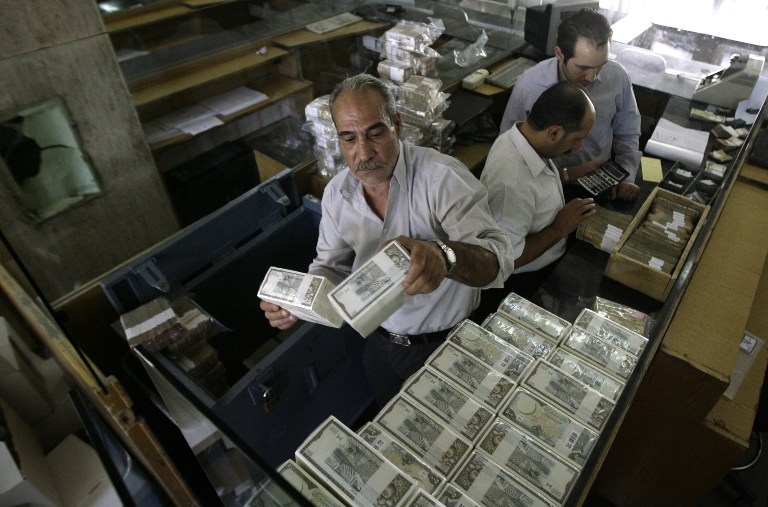Lost mines, oil fields further shrink Syrian government coffers

With most of its natural and mineral resources now under rebel control, Syrian state revenues have shrunk, leaving the government dependent on unstable sources of income for its survival, according to analysts.
Four years of conflict have decimated the state coffers. Now the government's only revenues are drawn from dwindling customs and income taxes, heavily bolstered by credit lines from key government backer, Iran.
With the rise of the Islamic State (IS) militant group, the government has also lost control over swathes of vital resources - with two phosphate mines among its most recent losses.
According to local activists and the Syrian Observatory for Human Rights monitoring group, last weekend IS seized Sharqiya and Khneifess, 50km southwest of the ancient city of Palmyra in central Syria.
Both sites were run by the state and accounted for much of the government's last remaining exports.
An oil ministry official said Sharqiya produced at least three million tons of phosphate a year and Khneifess generated 850,000 tonnes.
The seizure of the mines came as Syrian officials said Iran had given preliminary approval for a new $1bn credit line, the third Iranian credit line offered since 2013.
“Iran remains an ally of Syria,” the central bank governor Adib Mayaleh told Bloomberg.
Before the war broke out in 2011, Syria was the fifth largest phosphate exporter in the world, mainly selling to Lebanon, Romania and Greece.
In the first quarter of 2015, Syria sold 408,000 tonnes of phosphate in total, on the domestic market and abroad, according to the oil ministry.
Sales raised $39mn, with exports accounting for all but $4mn.
Oil revenues drying up
Already this year's exports have less than halved from the 988,000 tons sold in the first three months of 2011 that brought in $63mn for the government.
But with the loss of Sharqiya and Khneifess, prospects are dim for a government which projected income of $160mn in 2015 phosphate sales.
"For the state, whose resources are being depleted, it's a net loss. In the current situation, any returns are important," said Jihad Yazigi, who runs Syria Report, an economic weekly.
Syria's oil resources are not faring much better.
The government had relied heavily on oil revenues, which brought in $3.8bn in 2011, around a quarter of total state income.
But output took a drastic hit in 2011 when the EU imposed an oil embargo to sanction the government's brutal repression of anti-government protests.
The cash-strapped government has since lost control of a string of oil fields to IS militants.
In 2013, IS seized all the fields in the oil-rich eastern province of Deir Ezzor, generating funds for its operations.
By September 2014, IS was producing more oil than the government: 80,000 barrels per day, compared to the government's 17,000 bpd, the oil ministry said.
And by the end of last year, official production had plunged to 9,329 bpd, compared to pre-war output of 380,000 bpd.
According to Syria Report, IS seized yet another oil field from the government last week - Jazal, which produced 2,500 bpd.
Natural gas under threat
So far, natural gas fields have been the least affected by IS's rampage through Syria.
Oil Minister Suleiman al-Abbas said government-controlled fields produce some 10 mn cubic metres per day.
But the figure does not take into account the loss of Arak and Al-Hail, two fields in central Syria that IS overran earlier this month.
"Even if Syria had never exported its gas, it would still be crucial for electricity generation. Losing gas fields is a terrible blow to an already devastated economy," Yazigi said.
Before its complex and multi-front conflict broke out four years ago, Syria was a key exporter of agricultural products, textiles and leather, medicine, flowers and ceramic goods.
Total exports have plummeted from $11.3 bn in 2010 to $1.8 bn in 2014, according to the pro-government newspaper Al-Watan.
With export markets drying up, Syria has grown increasingly reliant on income taxes and customs, which brought in around $550mn in 2014, an official told AFP.
Middle East Eye propose une couverture et une analyse indépendantes et incomparables du Moyen-Orient, de l’Afrique du Nord et d’autres régions du monde. Pour en savoir plus sur la reprise de ce contenu et les frais qui s’appliquent, veuillez remplir ce formulaire [en anglais]. Pour en savoir plus sur MEE, cliquez ici [en anglais].




